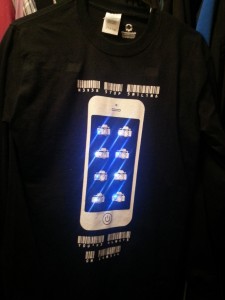
It is acknowledgeable that throughout human history, people have always recognized and maintained a sense of privacy. Nestled betwixt a plethora of issues facing this realization is the idea that there does not exist a single and precise definition of what exactly privacy constitutes. Dated research (circa 1881) presented an oversimplified yet often quoted idea that privacy was the “right to be let alone” (Craven Jr, 1979). It wasn’t until a few years later that the idea that privacy deserved legal protection began to circulate, spawning mass intellectual debates on the issue. Samuel Warren and Louis Brandeis produced a highly influential essay in Harvard Law Review in 1890 that introduced the fundamental principle that “the individual shall have full protection in person and in property… it is our purpose to consider whether the existing law affords a principle which can properly be invoked to protect the privacy of the individual; and, if it does, what the nature and extent of such protection is” (p. 37). In American society, as well as other western cultures, one of the most clear cut and expected notions of privacy involves the ability to control exposure of one’s body (Konvitz, 1966). The author discusses how culturally we are made to believe that being naked is something to be seen as shameful (as passages from the bible give way to this), and we have a right to not be exposed without or consent. While this project doesn’t focus on the distribution of anything pertaining to a violation of someone’s right to maintain privacy of their naked body, it does touch on having a right to not be publicly displayed to others, whether it be in concern to their body, clothing, etc., within certain public or private spheres without their consent. In discussing video voyeurism, Lance Rothenberg said, “The failure of criminal law to recognize a legitimate expectation of privacy in the public space tacitly grants the video voyeur a license to act with impunity, and leaves victims with little or no recourse” (2011, p. 1146). Voyeurism in this case is the action of spying on persons engaged in intimate behavior, such as undressing or other sexual activity considered to be private nature.
While again, the project is not focused on issues related to voyeurism, it pulls from Rothenberg’s thoughts in that individuals do maintain a right to privacy, even within a public space. Furthermore, they reserve the right to not be videoed or photographed without consent. Despite this right, there continues to be a rising social issue of people using potential devices of surveillance within realms of expected privacy. With the common implementation of the smartphone, the masses now possess video and photo capabilities all within a single device, and the culture associated with it subjects many people to non-consented exposure.
Of the many public spaces with assumed rights to privacy, fitness facilities and gyms are no exception. Whether it is on the weight room floor itself, or in a bathroom or dressing room, privacy is an essential part of the comfort individuals should have when partaking in fitness related activities in a gym. Regardless of this right, cell phone use in fitness facilities across the country continues to be a regular annoyance to both gym patrons and workers alike. “Use of cell phones on the gym floor while using equipment is dangerous for individual members and distracting to others,” Planet Fitness spokesman McCall Gosselin told the Huffington Post.
Because combating this issue is difficult, given that each gym has varying rules on cell phone use, I decided to take action. Knowing that it could lead to combative reactions by approaching each patron violating the expected norm of privacy by using a cell phone, I created the Surveillance Recognition gym shirt.
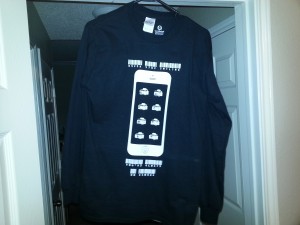
Obviously not as extreme or significant as the Zoot Suits of the 1940’s, the shirt draws on the same idea of developing an oppositional style with a deliberate message (Wilson, 2007). The shirt simply provides social commentary on the lack of privacy by displaying a head count or tally of the number of people within a public space with an expected sense of privacy who are violating the security of others. This is done so with a series of LEDs that have been sewn into the shirt. The LEDs are connected to an Arduino Lilypad and controlled with a button installed in the left sleeve.
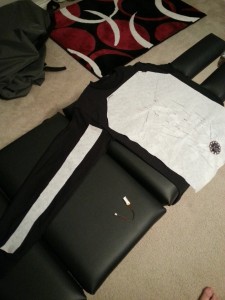
When pressing the button once, a single LED will light up and stay lit, which shines through a printed camera on the front of the shirt. In total, there are eight cameras, each with its own corresponding LED, that all fall within the frame of a large smart phone. As the button is pressed, a new LED will light up, while the previous ones stay lit, thus starting a running tally of the number of cell phones being used within a space. Once all the LEDs are lit, pressing the button again will turn off all of the lights, thus returning the count to zero.
The shirt is powered by a single rechargeable lithium-ion battery which plugs directly into the Arduino Lilypad. The Lilypad is connected to each LED by conductive thread which was sewn into garment interfacing underneath the surface of the shirt. The interfacing was attached to the shirt via Velcro strips that line the interior of the shirt. I chose to Velcro in the garment interfacing as opposed to sewing it because I wanted to be able to detach the interfacing. This was because, seeing as how the shirt will be used in a gym setting, it’d be highly appropriate to have the capability of washing the shirt. Therefore, all electronics within the shirt needed to be able to come out with ease, without interrupting the functionality of the shirt. Furthering on this concept, the garment interfacing is protected by a layer of plastic lining, also attached with Velcro strips.
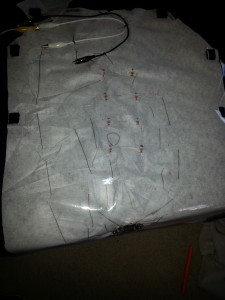
The plastic lining serves as insulation between the body of the person wearing the shirt and the electronics sewn onto the garment interfacing. This is to prevent sweat and moisture from disrupting the devices from functioning properly. Lastly, for both practical and comfort purposes, a layer of moisture wicking fabric was attached on top of the plastic lining. This was done so to aid in the effort of wicking moisture away from the electronics while also providing a layer of comfort, as opposed to having wet plastic lining rubbing against skin. Again, Velcro was used to attach the layer.
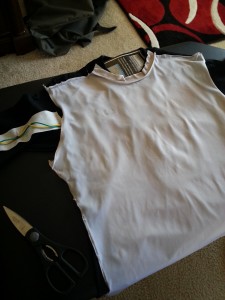
While the shirt by itself is not a ground-breaking or innovative concept that will revolutionize any particular industry, it serves the individual in a significant way. People should always be allowed to voice their concerns and even protest when it comes to what they perceive to be violations of their right to privacy, or anything else that may infringe upon any of their rights as citizens. This shirt allows people to silently raise awareness to their disdain or lack of appreciation for others performing actions that violate those rights.
References:
- Brandeis, L. &. (1890). The Right to Privacy. Harvard Law Review, 33-52.
- Craven Jr, J. B. (1979). Personhood: The Right to be Let Alone. Duke Law Journal, 699-720.
- Konvitz, M. R. (1966). Privacy and the Law: A Philosophical Prelude. Law and Contemporary Problems, 272-280.
- Rothenberg, L. E. (2011). Re-Thinking Privacy: Peeping Toms, Video Voyeurs, and the Failure of Criminal Law to Recognize a Reasonable Expectation of Privacy in the Public Space. American University Law Review, 49(5), 1125-1165. Retrieved from http://digitalcommons.wcl.american.edu/cgi/viewcontent.cgi?article=1306&context=aulr
- Wilson, E. (2007). Oppositional Dress. Fashion Theory, 253-255.

Leave a Reply
You must be logged in to post a comment.